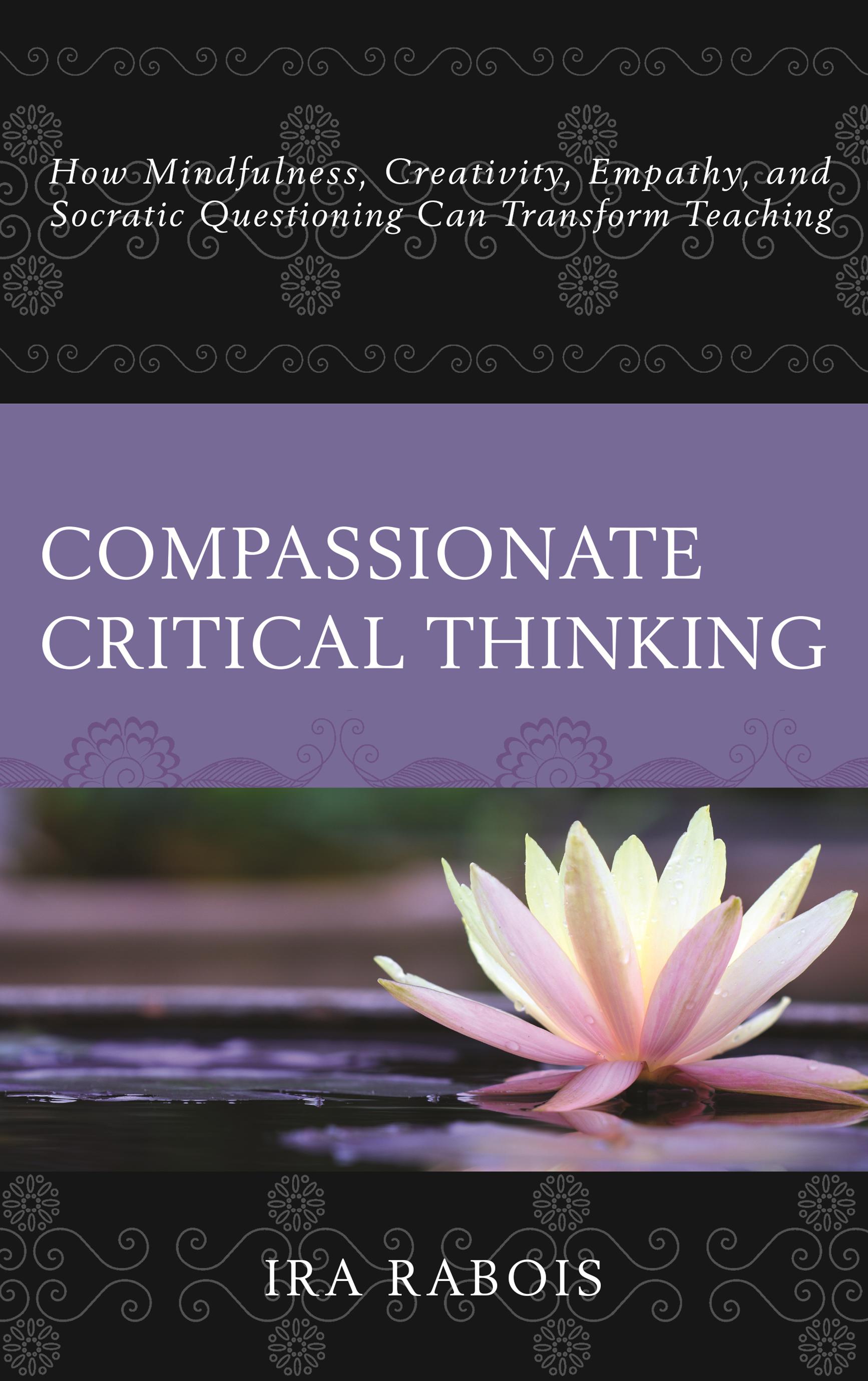 This week Rowman & Littlefield releases Compassionate Critical Thinking: How Mindfulness, Creativity, Empathy and Socratic Questioning Can Transform Teaching by Ira Rabois. In his new book, Ira demonstrates how to use mindfulness with instructional effectiveness to increase student participation and decrease classroom stress, and it turns the act of teaching into a transformational practice. Many books teach mindfulness, but few provide a model for teaching critical thinking and integrating it across the curriculum.
This week Rowman & Littlefield releases Compassionate Critical Thinking: How Mindfulness, Creativity, Empathy and Socratic Questioning Can Transform Teaching by Ira Rabois. In his new book, Ira demonstrates how to use mindfulness with instructional effectiveness to increase student participation and decrease classroom stress, and it turns the act of teaching into a transformational practice. Many books teach mindfulness, but few provide a model for teaching critical thinking and integrating it across the curriculum.
Ira Rabois recently retired from the Lehman Alternative Community School, a public secondary school in Ithaca, NY, where he taught English, Philosophy, History, Drama, Karate, and Psychology for 27 years. He earned a B.A. from the University of Michigan, a M.A.T. from SUNY-Binghamton, served in the Peace Corps, studied Zen and Japanese martial arts for 40 years with Hidy Ochiai, and took classes in meditation and Buddhist psychology at Namgyal Institute for Tibetan Studies, The Omega Institute with David Loy and Robert Thurman, healing meditation with the Consciousness Research and Training Project, and Proprioceptive Writing with Linda Trichter Metcalf and Tobin Simon.
Prior to his retirement, Ira Rabois began writing this book and contacted me in late 2012 for a professional assessment. After a round of revisions to his manuscript we began to work together on a book proposal and building his audience platform. He began to blog weekly and in 2014 was interviewed by Sasha Lilley on Pacifica Radio’s Against the Grain and by Tish Pearlman on WEOS/WSKG Radio’s Out of Bounds Radio. Ira’s book interested several publishers but it wasn’t until fall of 2015 that we found him a perfect match with Rowman & Littlefield where he worked with Sarah Jubar and her team to publish it. Patience and persistence describes Ira Rabois best as an aspiring author. He continued to work on this project to make it the best possible book.
I interviewed Ira by email about his new book and his path to publishing recently. Here’s our conversation.
 Jill Swenson: Why did you write this book?
Jill Swenson: Why did you write this book?
Ira Rabois: I wanted to show how mindfulness, imagination, and visualization could be a potent force in education, especially in teaching critical thinking. I read so many articles and books which portrayed public schools in a distorted and negative light that I couldn’t take it anymore. I wanted to show—not just tell—what real public school teachers do. People too often underestimate what is possible in schools, and just how insightful students can be—especially when relieved of the oppressive “teach to the test” dictates. I wanted to show how I motivated deep learning in students. And this might be pie-in-the sky, but if people can begin to think more clearly and empathically, there would be less violence and suffering and more understanding and care in the world.
Jill Swenson: Who were you writing it for? And what effect do you hope it has on readers?
Ira Rabois: The book is written primarily for secondary school teachers, but can be adapted easily for college, and with some work, for elementary education. I also thought teenagers could read it as a guide to their own learning. And parents can read it for themselves and to help their children. I hope it helps readers be happier, think more clearly, better understand themselves, and their emotions. And then teach this to others.
Jill Swenson: What did you learn in your last years of teaching that you hadn’t already known when you first began as a teacher?
 Ira Rabois: I learned so much more than I could ever put into words. Students helped keep my mind young and demanded creative responses from me. When I first started teaching, I used mindfulness practices only on selected occasions, or when students asked for it. At the end, I used it every day. And I learned techniques and practices that worked best for different age groups and different students, so I could learn from the students how to teach them.
Ira Rabois: I learned so much more than I could ever put into words. Students helped keep my mind young and demanded creative responses from me. When I first started teaching, I used mindfulness practices only on selected occasions, or when students asked for it. At the end, I used it every day. And I learned techniques and practices that worked best for different age groups and different students, so I could learn from the students how to teach them.
Jill Swenson: How did your teaching change over the course of 38 years?
Ira Rabois: When I started, I was not so sure of myself, since I hadn’t taught in a formal school setting, except for Karate, for 10 years. I learned how to trust myself, how to constantly expand my “comfort zone” and trust the ability of my students. I had to rediscover my own resources, one of which was my stories. Stories can be a miraculous resource and was one resource I could use right away. I loved deep conversations. I had a passion for teaching, however, a drive to constantly improve and to understand what I was teaching in more and more depth. I tried to talk with students, so I could get to know them better and connect their lives to the course material.
Jill Swenson: How did the students change over the course of your teaching career?
 Ira Rabois: That is difficult to answer. Certainly, there was more anxiety in students when I retired than when I started, but there has always been stress. There was more pressure to be constantly busy, to do things, join mock trial or sports or dance or other organized groups that you could list in resumes and college applications—to grow up faster and avoid having free, unorchestrated time. The ever presence of social media and computers is relatively new and can increase the pressure on students. 9/11 added to this anxiety, as did increasing social inequity and concentration of wealth in fewer hands. On the other side, there is more openness to meditation and new research on mindfulness and the way the brain works.
Ira Rabois: That is difficult to answer. Certainly, there was more anxiety in students when I retired than when I started, but there has always been stress. There was more pressure to be constantly busy, to do things, join mock trial or sports or dance or other organized groups that you could list in resumes and college applications—to grow up faster and avoid having free, unorchestrated time. The ever presence of social media and computers is relatively new and can increase the pressure on students. 9/11 added to this anxiety, as did increasing social inequity and concentration of wealth in fewer hands. On the other side, there is more openness to meditation and new research on mindfulness and the way the brain works.
Jill Swenson: Why does a teacher need to practice mindfulness before they teach others to use mindfulness?
Ira Rabois: Because otherwise you are not authentic. You can’t speak from your own experience. You can’t advise students to practice something that you don’t do. You can’t teach what you don’t know.
 Jill Swenson: How did your involvement in learning martial arts affect your teaching?
Jill Swenson: How did your involvement in learning martial arts affect your teaching?
Ira Rabois: It made my teaching stronger. It improved my focus, concentration, confidence, discipline, and awareness. It gave me the strength to be empathic, to be tough or comforting, depending on the situation and the student.
Jill Swenson: What surprised you about the process of getting a book published?
Ira Rabois: So many things! It was all a revelation. I learned so much about myself. I’m proud of what I did. But I initially thought a book was an individual achievement. I was wrong. Getting my book published took a community of people—from working with you and your team, to the various people who work for the publisher, especially Sarah Jubar, the editor who primarily worked with me. And then there were my teachers, co-workers, and former students who gave me intellectual and emotional support, editorial feedback, and helped me make important contacts.
Jill Swenson: What was the hardest part for you in getting to publication?
Ira Rabois: Constant re-writing. In a three-week period, I re-wrote the entire book, turning it from first to third person, for example. Also, being asked to help market the book. And, yes, getting involved in social media. I am not naturally attracted to social media.
 Jill Swenson: And yet, you’ve built a strong following with your blog and on Facebook. What advice would you give other writers who seek publication?
Jill Swenson: And yet, you’ve built a strong following with your blog and on Facebook. What advice would you give other writers who seek publication?
Ira Rabois: Find a good book development editor and agent to take some of the burden off your shoulders and be a guide in areas you might know little about. Be in touch with your feelings and thoughts. Be clear and honest about what you want, no, need to say. And be good to yourself. Patient and persistent. Take all seeming setbacks as lessons, opportunities.
Jill Swenson: Thanks, Ira. It isn’t easy to get a “rejection” and move forward. You clearly embraced the few setbacks along the way as challenges to make this an even better book than you first imagined. Congratulations on the release of your new book. I highly recommend it, whether you are a teacher or not, to learn more about compassionate critical thinking.

I worked with Ira in the Lehman Alternative Community School, in his classroom, as a special education teacher. So I was very happy to learn of his recent accomplishment. Can’t wait to read the book. Congratulations to you and Ira.